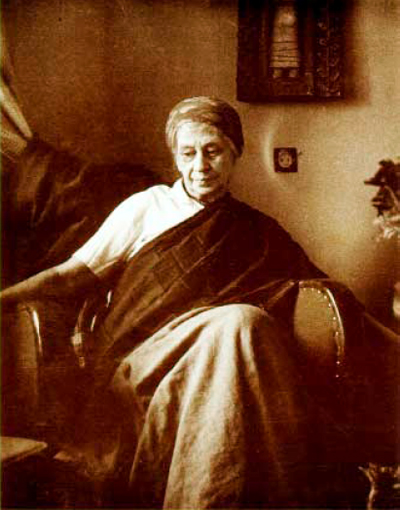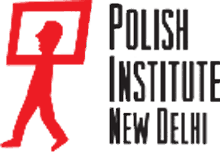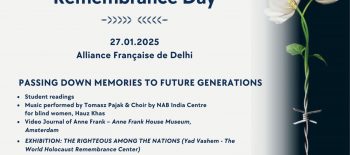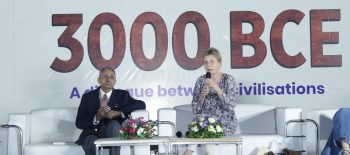
March 2025 marks Wanda Dynowska’s 54th death anniversary. On this occasion, we would like to share an article by Maria Puri on this eminent personality.
Wanda Dynowska. An Enlightened Soul.
Wanda Dynowska was born to a well-to-do Polish family in 1888 in Sankt Petersburg, Russia; in 1935, already close to fifty, she came to India and stayed there till her death in Mysore in 1971. Most of her childhood and youth was spent in her family’s country estate, in today’s Latvia, where she had a chance to read widely and meet many eminent intellectuals visiting her advocate-father. Among them was Tadeusz Miciński (1873-1918), a leading representative of the Young Poland literary movement, a prolific writer deeply influenced by Indian spirituality, and a member of the Theosophical Society1. It is often assumed that people such as he exerted great influence on Wanda Dynowska’s thinking. She, however, always maintained that her personal beliefs evolved as a result of a self-realization achieved sometime between the age of 16 and 18, when she became convinced that the notion of reincarnation was the only logical explanation capable of shedding light on the mysteries of life. Much later she mentions in her writings2 that J.C. Chatterji’s book3 on esoteric philosophy of India, the very first theosophical text she read, made a great impact on her and shaped her future thinking.
Before the outbreak of the First World War in 1914, Dynowska, already fluent in several languages, studied French Literature at the Jagiellonian University in Cracow, Poland, and later, in Lozanne, in Switzerland. She spent war years in Russia with her mother, but after the end of the war and the rebirth of Poland as an independent state, she came to Warsaw. In 1919 she began her efforts to establish the first truly Polish unit of the Theosophical Society. In the same year she travelled to France to meet Annie Besant (1847-1933), the president of the Theosophical Society, but for some reason the two did not meet, though Dynowska did receive from her a letter of support. Instead, she met Jiddu Krishnamurthy (1895-1986), who made great impression on her and remained a life-long influence in her life.
In 1923 Dynowska succeeded in her efforts. At the European Congress of the Theosophical Society in Vienna she received from the hands of Jinarasadasa (1875-1953), the then vice-president of the Society, a charter to form Polish Lodge with herself as the first secretary general of the newly established unit. The Society became her whole life. She started working feverishly, pouring her thoughts on paper, and writing numerous essays and books; she also begun editing a theosophical journal4, translated numerous theosophical works from different European languages into Polish, and even managed to bring them out in print in a publishing house specially founded for this purpose in 1924 and called “Adyar” after the theosophy center in India. She lectured extensively on theosophy and often traveled not only within Poland but all over Europe to attend theosophical congresses and meetings. She was also very vocal in matters of social and cultural importance. Current affairs and politics claimed almost as much of her attention as theosophy and she always remained a strong supporter of the charismatic Polish leader, Marshal Piłsudski. Soon after his death in 1935, she decided to leave Poland for India to attend a theosophical congress there and after a long sea voyage arrived in Adyar (then in Madras, now Chennai), the headquarters of the Theosophical Society.
While in India, Wanda Dynowska initially stayed almost exclusively in Adyar. Soon, however, she came under the influence of Shri Ramana Maharishi (1879-1950) and moved to his ashram to be near him. She even started translating his books into Polish though for a long time she did not sever her earlier links with theosophy. Through her friends, many of whom were deeply involved in the Indian independence movement, she met Mahatma Gandhi (1869-1948) and was impressed by his personality, way of life and teachings. She often visited him in his ashram in Wardha (now in Maharashtra), and several of her poems were written there. It was Mahatma Gandhi who gave Wanda Dynowska her Indian name, Uma Devi, under which she is best known in India. Their close friendship is attested by Mahatma Gandhi’s many hand-written letters to Uma Devi, some of which may be viewed on the internet. When on 1 September 1939 Germany attacked Poland, Wanda Dynowska immediately made up her mind to return to her war-torn homeland. She wrote to Mahatma Gandhi telling him of her decision and his magazine “Harijan” published her farewell letter (of 8 Sept 1939) to Mahatma Gandhi as well as his answer to her.
Wanda Dynowska did reach Europe, more exactly Romania, but was unable to reach Poland. But even in a place far away from the actual battlefields she could see the extent of the devastation and her heart bled for the fate of the hapless refugees. She went back to India, which she reached after almost a year, and driven by feelings of patriotic duty, she offered her services to the Polish Consulate in Bombay. Being fluent in English, she was put in charge of the publications division and publicity. She travelled all over India lecturing on Poland and its plight. She had a hand in bringing out a Polish bi-weekly magazine called “Polacy w Indiach” (“Poles in India”)5 and its children’s supplement, “Słoniątko w Indiach” (“Baby Elephant in India”). As long as the war lasted, she did her bit and more for the war effort. She was tireless in all actions aimed at helping Polish refugees, especially those, who at the very beginning of the war were deported by Russian forces from the eastern parts of Poland to Siberia and Central Asia, and who in 1942 were finally allowed to leave Russia for Persia and from there, travelled to India. A number of transition camps and two refugee camps were soon set up for Polish citizens: one for the orphaned children in Balachadi in today’s Gujarat, and another, for families, mostly mothers and children, in Valivade near Kolhapur in the present-day Maharashtra. Though not formally involved with the administration of the camp, she often visited Valivade and interacted with the inhabitants many of whom mention her in their memoirs written years later. She took part in cultural activities at the camp, even writing textbooks on Indian geography for Polish schools and organizing a South Indian trip for a group of children lodged there.
In 1944, in collaboration with Harishchandra Bhagavatishanker Bhatt6, a young Gujarati poet employed in the Information Department of the Polish Consulate in Bombay, Wanda Dynowska published a book of poems translated from Polish, “Scarlet Muse: An Anthology of Polish Poems” as well as a monograph on Marshal Piłsudski written by Bhatt in Gujarati, and later translated also into Tamil. In the same year 1944, together with Maurycy Frydman (1901-1972), a close friend, also of Polish origin, and like Wanda Dynowska, a long-time resident of India, she established in Madras a publishing house called Biblioteka Polsko-Indyjska (Indo-Polish Library), in order to publish books in Polish. They were mostly translations from English and Indian languages, but also included works written by Wanda Dynowska herself. The institution functioned till 1971 (though in 1969 Wanda Dynowska withdrew herself from the venture and gave full charge to Maurycy Frydman) and published around 140 volumes. Among them were her own translations of Bhagavatgita and Tirukural; writings of Jiddu Krishnamurthy, Shri Ramana Maharishi, Shri Aurobindo, Vivekananda, Mahatma Gandhi; Tagore’s “Sadhna”; books on yoga, Hinduism, Buddhism and Indian culture; an anthology of Indian poetry, with separate volumes dedicated to languages such as Sanskrit, Tamil, Gujarati, Marathi, Hindi and Bengali; two volumes of Tibetan poetry, as well as her own poems, travelogues and spiritual writings.
Sometime after the war, in the late forties or early fifties, Wanda Dynowska took a step forward in her individual spiritual development and broke all ties with religious institutions, which took so much of her early life, among them the Theosophical Society, though she continued to stay in the Adyar headquarters whenever in Madras. At one point in time, she decided to visit Poland, which she had not seen since 1935, and she went twice, in 1960 and 1969, both times remaining there for a couple of months. She lectured extensively on Mahatma Gandhi, Krishnamurthy and Shri Ramana Maharishi, as well as religion (especially Hinduism and Buddhism) and culture of India, and also her own spiritual development. Her visits were fruitful, and her lectures well attended as her writings and translation were for a long time the only literature on India available in Poland. Hence, all her books were very popular and often reprinted, up to present times. Both times while in Poland she met Cardinal Wojtyła, the future Pope John Paul II. During her first visit she presented him with the volumes of her Indian Anthology in Polish and spoke to him about the plight of the Tibetan refugees.
For in 1960 Wanda Dynowska turned her eyes to the Tibetan refugees, who, with Dalai Lama’s flight from Tibet to India in 1959, started to come to India in great numbers. Thus begun a new and last chapter of Wanda Dynowska’s life. She shifted to North India, to Dharamshala, the capital of the Tibetan government-in-exile, and begun working with the refugees there. She taught in school, stitched clothes for children, worked in dispensaries, even helped with cooking and other house-keeping chores at the school and the orphanage. There was no work she deemed below her. Later however, due to age and health reasons, she would spend only the summer months in Dharamshala and in autumn, when Dharamshala grew too cold for her, she would move to the South, at first to Adyar, and then to the Tibetan refugee settlement in Bylakuppe, near Mysore in Karnataka. Her interest in Buddhism grew; she developed close friendship ties with many Tibetans and translated a number of books on Buddhism into Polish. But her main work was with children and young adults, who would visit her at her home and who remember her fondly even now.
In 1970 Wanda Dynowska’s health took a turn for the worse. She could no longer stay on her own in the Bylakuppe settlement and moved to Nirmal Convent, a Catholic establishment in Mysore. It run a boarding school for girls and a number of her Tibetan pupils studied there. Two of them helped Mother Superior and a Polish nurse living in South India to take care of their ailing teacher. She was often visited by the Tibetan monks who offered her much needed succor. At one point, through the intercession of the Catholic archbishop of Mysore, a Polish priest, Father Marian Batogowski got in touch with her. When her condition deteriorated further, she refused to take medicines anymore. On 20 March 1971, she requested Father Marian Batogowski to say the Mass and give her the sacrament. Then, dressed in red sari, she assumed meditation position and went into a trance. She died sometime before midnight. The priest, who was with her throughout, wrote later that he felt privileged to be of assistance to a being like her in passing from this world to the next. In conformance with her last will and with the assent of the archbishop, the same night her Tibetan friends took her body to Bylakuppe where the funeral rites were performed in accordance with the Tibetan customs. Later a stupa was erected over her body.
Wanda Dynowska, with her mesmerizing personality and a colorful life, exercises Polish imagination even today. Many of her books are available in the present-day reprints and she is the subject of much scholarly research.
Maria Puri
The first section of the Theosophical Society on Polish soil but basically a part of the Russian chapter was established in 1905 and was called Alba. It had, as its members, such prominent writers as Eliza Orzeszkowa, Tadeusz Miciński and Maria Rodziewiczówna. ↩︎
Wanda Dynowska, “Razem pod wiatr.” (“Together against the wind.”) Biblioteka Polsko-Indyjska (Indo-Polish Library), Bangalore 1948. ↩︎
The book was published in English by the end of the nineteenth century and soon had French and Spanish translations. Polish translation appeared in 1926, but Wanda Dynowska, who, besides her native Polish, was fluent in many other languages (Russian, Latvian, French, Italian and Spanish), might have read it in any of the early editions. ↩︎
“Przeglad Teozoficzny” ↩︎
It was published till 1947 by which time most of the Polish refugees left India. ↩︎
Harishchandra Bhagavatishanker Bhatt (1906-1950) was honored with the Order of Polonia Restituta (Order Odrodzenia Polski) for his contribution to spreading awareness about Poland. ↩︎



